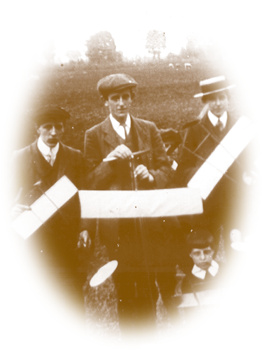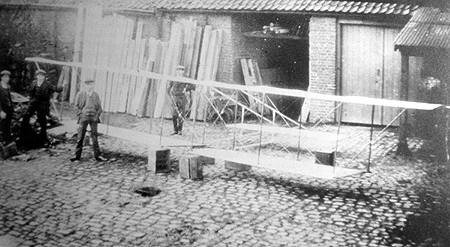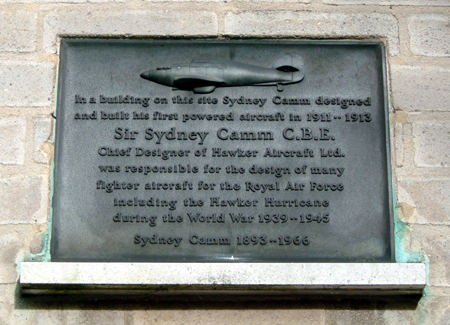
A Short
History of Sir Sydney Camm CBE, FRAeS
1893 - 1966
Updated January
2007

Sydney Camm as a teenager in
the Home Park where he flew his first aeroplane models
Sydney Camm, one
of Britain's most distinguished aircraft designers, was born
in 1893. From his schooldays he had shown a keen interest in
aviation, founding the Windsor Model Aeroplane Club and constructing
many successful model aircraft. As a child he lived at No. 10
Alma Road, with his siblings one of whom was Fred Camm who was to become editor
of the famous 'Practical...' series of magazines. Sydney Camm was a pupil
at The Royal Free School, Bachelors
Acre, leaving at the age of 14 in 1908.
Camm's father, was an excellent carpenter
and joiner and must have instilled in Sydney an interest in hand
work, accuracy and quality. He used to spend hours whittling
propellers for model aeroplanes. The brothers became sufficiently
competent in building reliable model aeroplanes that they supplied
Herberts' Eton High Street shop. Their models of biplanes and
monoplanes were advertised as "Will Really Fly", and
"Will Rise from the Ground". They found that a better
price could be obtained by direct sales to the Eton College boys
- these had to be delivered, at night, via a string lowered from
the Eton boys' dormitories to avoid attracting the attention
of the school authorities - and by Herbert's who were not amused
to find out what was happening.
 Sydney
Camm and his friends with their full sized glider
Sydney
Camm and his friends with their full sized glider
Sydney Camm and
his friends built a full sized glider with plans to put an engine
on it, seen here in the former Borough depot, Alma Road, circa
1912. The building abutted the Borough Engineer's office, on
the north side, with access from Arthur Road. There are said
to be photos in the archives formerly held at Kipling Building
and now believed to be held in the Borough Collection, Tinkers
Lane.

The site
of the workshop where Camm and his friends constructed their
glider is commemorated here with a plaque on a wall in Ward Royal
 The plaque
is located beneath a window in Athone Square, Ward Royal
The plaque reads:
"In a building
on this site Sydney Camm designed
The plaque
is located beneath a window in Athone Square, Ward Royal
The plaque reads:
"In a building
on this site Sydney Camm designed
and built his first powered aircraft in 1911-1913.
Sir Sydney Camm C.B.E.
Chief Designer of Hawker Aircraft Ltd
was responsible for the design of many fighter aircraft
for the Royal Air Force
including the Hawker Hurricane
during the World War 1939-1945
Sydney Camm 1893 - 1966
In 1914 Sydney
Camm joined Martinsydes of Brooklands as a woodworker and was
fortunate to come under the influence of G H Handasyde, one of
the leading aircraft designers of the day. He assisted Handasyde
with design work until, in 1923, he joined the Hawker Engineering
Company, successor to the Sopwith Aviation Company Ltd, as a
senior draughtsman. Within two years Camm had been appointed
Chief Designer. He was to remain with Hawkers for forty-three
years until his death in 1966.
Camm's remarkable
series of successful aircraft designs range from his Hawker Cygnet
biplane of 1924 to the VTOL P1127 of 1960 and included such immortals
as the Hart and the Hurricane. The beautiful little Cygnet weighed
only 375 lb and was the Hawker entry for the Air Ministry Light
Aeroplane Competition at Lympne in 1924.
In 1925, with Fred
Sigrist, Hawker's Managing Director, Camm developed the distinctive
Hawker metal construction, using cheaper and simpler jointed
tubes, rather than the alternative welded structure. In the late
20s and early 30s Camm designed the classic Hart family of fabric
and metal biplanes. The Hart's success put Hawker in the front
line of aircraft manufacturers and its design was used by Camm
as a basis for aircraft to meet other requirements. These included
the Demon fighter, the Hart trainer, the Audax army co-operation
aircraft, the Hind, the Fury, the Osprey and the Nimrod Fleet
Air Arm machines. This new generation of aircraft boasted performance
far in advance of their contemporaries. At one time in the 1930s
no fewer than 84 per cent of the aircraft in the RAF were of
Hawker/Camm design.
Official prejudice
had for many years precluded the adoption of monoplanes by the
RAF, but Camm managed to overcome the Air Ministry's apprehension
with his superbly designed Hurricane. This, Camm's most famous
aircraft, was based on the Fury. Together with Mitchell's Spitfire,
it played a leading role in the Battle of Britain, the Hurricane
shooting down more enemy aircraft than all other British aircraft
and ground forces combined. Almost as celebrated were Camm's
high-performance, piston-engined, Typhoon, Tempest and Sea Fury
aeroplanes.
After the Second
World War Hawkers did not rush into the new field of jet propulsion
but, as always at the propitious time, they brought out the Sea
Hawk and swept-wing Hunter jet fighters, both designed under
the direction of Camm. The Hunter, one of the longest lived jet
fighters and ground attack aircraft, first flew in 1951.
Towards the end
of his career Sydney Camm was closely associated with the very
advanced concept of vertical take-off and landing. The P1127,
a forbear of the Harrier, which made its first vertical take-off
in 1960. A clear line of development can be traced throughout
its design. The P1127 prototype is on display at Brooklands Museum,
Weybridge, together with a Hunter and a replica Hurricane.
More of a perfectionist
than an innovator, Camm's designs evolved logically, progressively
and successfully from each other. Although Camm started his career
without any advanced scientific training, he had a masterful
eye and an intuitive feel for a well-designed aeroplane. Endowed
with these rare gifts he produced a succession of aircraft that
were not only extremely good-looking but also boasted excellent
performance and handling characteristics.
Sydney Camm, acclaimed
by Sir Thomas Sopwith as being the greatest designer of fighter
aircraft the world has known, received the British Gold Medal
for Aeronautics in 1949, was elected President of the Royal Aeronautical
Society in 1954 and received its highest honour, the Gold Medal,
in 1958. Sydney Camm was knighted in 1953. In 1966 Sir Sydney
Camm was awarded the Guggenheim Gold Medal, the leading American
aeronautical award, which had to be presented posthumously. He
died in 1966 at the age of seventy-two.
Sir Sydney once said, "The main
requirements of an aircraft designer were a knowledge of aerodynamics,
some elementary maths, and an eye for beauty." He had
a sharp eye for picking out a poor piece of design. His comments
such as 'struts like floorboards' were long remembered. His dedication
to aircraft design was to last over 50 years, a dedication that
lead to his being knighted, the award of the Gold Medal and Honorary
Fellowship of the Aeronautical Society and the Daniel Guggenheim
Medal in 1965 - an honour that he heard of shortly before his
death in 1966.
His designs will be seen by future generations
in that part of the RAF Museum at Hendon which is set apart in
his memory.

The
plaque illustrated above was originally unveiled in 1986 on No
10 Alma Road, Windsor, but has since been removed, probably stolen.
A new plaque has now been installed
In 2007 plans are well advanced to erect
a Hurricane replica in Windsor by way of a memorial.

To contact us, email Thamesweb.
|

